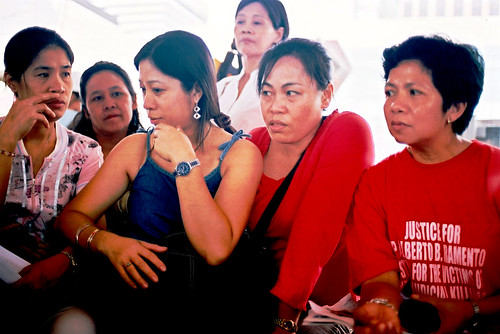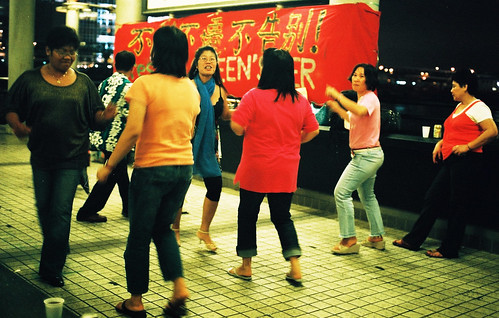想罵很久了。早陣子《明報》有篇十年回顧報道,寫的是外傭。文章的主要部分竟然是由一個香港「印尼之父」講印尼傭工點樣「易話為」,人工少d、替主人在住家以外打工都得,相反菲律賓人就「麻煩得多」,熟悉勞工法例所以下下同主人爭拗爭權。一名筆者認識的菲律賓勞工權益組織者,在訪問稿中被小丑化,編輯選擇的quotation是「菲律賓人剩下的賣點就是有男人」。
如此赤裸地歧視外傭權益,令我想起十幾年前讀中學時,輿論群起批評菲律賓外傭星期日「霸佔」中環。當年就算是批評政府的人,也只會說政府應該為菲傭預備多些室內的活動中心,好讓她 / 他們不用在街頭流連,絕少有人說坐在中環街頭是菲律賓人的城市權,更沒有人說要多謝她們為本地人拓闊了對使用公共空間的想像、或者為本地人爭取了更多的公共空間。
我從小時候盲目認同對菲傭的歧視,到現在親身體會她們對拓展香港公共空間的貢獻,上星期日﹝六月十七日﹞,我第一次有機會面對面向菲律賓朋友表達我的謝意。我說,她們用自己的身體,將中環這個「百多年來以城市規劃展現殖民者對異類的歧視的核心區域」扭轉過來。反應遲純的我,要到去年才開始做同一件事。因此,在保衛皇后碼頭及整片公共空間的運動裏,外傭理應是順理成章的伙伴。本土行動一直有意與她們一起舉辦工作坊,上星期日終於成事。
家庭傭工一個星期才有一天假期,人在他鄉特別容易苦悶,因此要她們放棄難得的與同鄉相聚的時間參加工作坊,不容易。菲律賓朋友daisy替我們在現場呼籲,二十多人在三點半聚集於queen's pier的牌匾前,先是聽本土行動報告第三期填海規劃的問題,然後是討論時間。時間不多,以下總結一些重點。
●不同地方的家庭傭工各有聚腳的區域。菲律賓人在中環和尖沙嘴、印尼人在銅鑼灣、泰國人在九龍城、尼泊爾人在佐敦和石崗等,而在一個聚腳區中又會細分為不同省份。匯豐銀行是一個小區、皇后像廣場和遮打道是一個小區、在大會堂及皇后碼頭聚腳的,大多是來自菲律賓西北部伊羅戈區﹝Ilocos Region ﹞。因此,皇后碼頭被拆、愛丁堡廣場消失,首當其衝的就是伊羅戈地區的菲律賓外傭,整個省的人要找地方搬。
●正於ahchoi之前的報道,不要以為菲律賓外傭只在香港逗留短時間,她們很多在香港已生活了十多二十年,對中環這片地方比一般人要熟悉得多。在參與工作坊的菲律賓朋友中,就有不少人見證着九十年代初菲律賓團體聯署爭取在中環街頭聚腳的權力﹝據他們說,是一九九二年﹞。一些很微細的變化也會影響她們,譬如皇后碼頭的平價小食亭結業,外傭被逼光顧較貴的大會堂美心快餐,對她們來說是一件不小的事情。又譬如,當天星碼頭和皇后碼頭之間一節海濱圍起了板後,一批每個星期都相約在那裏練習跳舞的菲律賓人就失去了最多觀眾的表演地點。其中一人說:「之後就沒有地方搞活動了。」
●伊羅戈區的朋友在皇后碼頭辦的活動包羅萬有。最開心的是生日會;從二零零二年開始辦伊羅戈語音樂節﹝查wikipedia,菲律賓是一個多民族多語言的國家,活語言和方言超過一百七十種,伊羅戈語是菲律賓北部的共通語。
﹞;二零零五年底在香港舉行的世貿部長級會議,伊羅戈區的朋友有組團去示威;二零零七年一月,他們在皇后碼頭舉行集會,抗議菲律賓政府向外傭加徵新費用;在工作坊舉行的同日,又有一班朋友在討論菲律賓國內愈來愈猖獗的政治謀殺。
●在她們的眼中,香港警察對外傭尚算不錯,很少會干涉她們的活動。如果是在菲律賓,警察動不動就打人了。她們對於皇后碼頭清拆不是沒有意見的,只是眼見本地人﹝即本土行動等民間團體﹞抗議這麼久都沒用,就覺得自己身為外傭除了逆來順受外能做的不多。然而,當我提到有人認為外傭根本不會真意關心香港的城市規劃問題,在場就有人不滿地反駁:「那些人怎會知道外傭沒意見,在這裏,有些人根本不當外傭是人,便理所當然地認定外傭不會關心。」
●那她們對於中環新填地的規劃有何意見?「最好是保持原狀。什麼也不要變。」「最好不要填海,如果真的要填,皇后碼頭前建一個內陸湖肯定比建公路﹝p2路﹞要好。」「擔心新海濱在興建解放軍碼頭後,當局會限制我們的活動。」
林鄭月娥在榮升發展局長的記者會上,表示將會走入群眾,與保衛皇后碼頭的人會面。在林候任局長的口中和眼中,反對拆散碼頭的只有那一小撮留守碼頭的人。作為對林候任局長的回應,本土行動在今日﹝六月廿四日﹞下午三點聯同菲律賓外傭朋友在皇后碼頭舉行記者會,公布一項菲律賓外傭對保留皇后碼頭及整片公共空間的調查結果。林候任局長,你要聽意見,請你先聽被你遺忘了的菲律賓外傭的意見。她 / 他們是這地方的主要使用者!
附件一 調查結果﹝六月廿四日晚上更新﹞
Queen’s Pier celebrates cultural diversity
76% Immigrant Workers from the Philippines want the Queen’s Pier to be preserved in situ without demolition
Survey report by Local Action
June 24, 2007
Practice performance (left) & workshop on Queen’s Pier on 17 June, 2007 (right) Photographer: Wong Ching
Local Action conducted (1) a survey on the usage of Queen’s Pier as a public space between 10-20 June, 2007, and (2) a participatory workshop on 17 June, 2007 to voice the opinions of its major stakeholders, our friends from the Philippines. Around 800 questionnaires were distributed to the Filipina/o workers through their various organizations and through direct distribution while they gather at Central during their holidays, i.e. on the 10th, 17th and 19th of June. 146 completed surveys were collected and analyzed by 19th June. We will continue to collect completed questionnaires and update the results of the survey. See appendix A for the results of the survey.
Below are the major findings of the survey.
1. Queen’s Pier is a place with strong regional identity
The most attractive features of Queen’s Pier to the immigrant workers is that it is a public space that is ‘free to use without charge’ (77%), has ‘beautiful scenery,’ (46%) and allow them to ‘meet with friends from (their) hometown.’ (See Q1) Our follow-up interviews show that Filipino and Filipina workers from different parts of Philippines have their own favorite spots in Central. Those who gather at Queen’s Pier, City Hall and Star Ferry are Visayan people from the central part of the Philippines. They speak Bisaya. More commonly, they identify themselves as coming from Ilongos. Most of them belong to three hometown organizations: the Capiznon Association, the Ilongos Association and the Passi City Association. Queen’s Pier is not merely any public space but a place to meet hometown people from around Ilongos. We have seen 3 generations of family members hold reunion parties, family gatherings and birthday parties at Queen’s Pier frequently. Queen’s Pier is not any public place. It is a home away from home for Ilongos people, who cannot afford to gather at expensive restaurants and shopping malls.
2. Queen’s Pier – a symbol of metropolitan city life that celebrates cultural diversity
Immigrant workers tend to have long working hours (e.g. 12 hours a day) with the lowest pay in Hong Kong. Sunday becomes their essential date to get away from their routine job. 84% come here once per week (Q2) and 26% said they stay for more than 10 hours (Q3). While most Hong Kong people rest at home, Filipinos and Filipinas have to leave their ‘home’ (their work place) to their ‘real home’ in public space such as Queen’s Pier. Q4 and Q5 show that immigrant workers have very diverse usages of Queen’s Pier, from family reunions, cards playing with friends, practicing performances, birthday celebrations, enjoying fireworks, and holding programs for various organizations.
A real metropolitan city welcomes everyone, rich or poor:
Without public spaces like Queen’s Pier, Hong Kong cannot be the metropolitan city that it claims to be because working class ‘foreigners’ have nowhere to go. Thus, public spaces like Queen’s Pier are most critical in enriching the city with cultural diversity, which is highly celebrated by any genuine metropolitan city.
3. 76% DO NOT want demolition and want preservation in situ
Given that Queen’s Pier (and also City Hall and Star Ferry) is so important to the Filipino/as’ community as an irreplaceable ‘home away from home’, it is not surprising that they strongly demand to preserve it in situ. Hong Kong people have been sharing this wonderful public space with foreign workers for over 2 decades. Queen’s Pier, City Hall and Star Ferry have become the celebratory symbol of cultural diversity, where locals and foreigners co-exist in harmony because it is a self-regulated public space with little state interference. There is no way we can recreate or reinvent the milieu (atmosphere) of Queen’s Pier. It has been nurtured slowly by diverse cultures and users over 5 decades. With multiple layers of historical and social meanings and multiple usages, Queen’s Pier is not only a public space, but a place that celebrates cultural diversity and tolerance.
4. More seating & better shelter against sun and rain
To our surprise, Queen’s Pier is truly a public space without much unnecessary regulations from public authorities or security guards. Harassment and conflicts with authorities or security guards are infrequent. Q7 and Q8 also show that immigrant workers will be happy to see improvement in better seating facilities (more chairs, tables or wooden platforms) and sheltering facilities against sun and rain. Since they spend a lot of their most valuable day off time at this place, a city that embraces diversity should really try to meet their basic demands, which can benefit local users as well, instead of demolishing it and replacing it with a 40m wide highway or exclusive shopping malls.
Appendix A: The survey results
Q1. What do you like most about the Queen’s Pier? (can choose more than 1 answer)
A - Free to use without charge 77%
B - Strong positive feelings of this place 18%
C - Free to use with minimum government 14%
D - Can meet with friends 45%
E – Convenient 36%
F - Panoramic view of Kowloon 24%
G - Beautiful scenery 46%
H – Other 1%
Q2. How often do you come to the Queen’s Pier area (including the City Hall and Star Ferry)?
A - Once per week 84%
B - Twice per week 4%
C - More than once per week 9%
D - Once per month 3%
E – Other 1%
Q3: How long do you stay here?
A - 2 - 3 hours 23%
B - 4 - 5 hours 14%
C - 6 - 7 hours 19%
D - 8 - 9 hours 17%
E - More than 10 hours 26%
Q4 When was the first time you come here? With whom? (Write your answer below.)
• 1989, family outing
• Since I arrived in 1992, I usually meet my friends here
• The first time I came here with my relatives & friend this place that we meet since 1994, till this year, 2007. The place we’re like to stop by and sit beside
• Last 1994, with my friend from my hometown
• 1995, With friends
• 1996, With friends
• Since I arrived HK during my first day of way back 1996
• When i lost my job (1997 June), i just kept walking and suddenly noticed that, i am in a refreshing view at Q.P,
• 1999, With friends
• Since 1999, I came in Hong Kong and all my friends and my sister always meet in Star Ferry every holiday
• 2002, with Friends
• 2003, party with family
• Since 2001, with my friends & relatives
• my first Sunday off up to the present and friend
• when I was new comer in hk watching the fire work
• Every holiday with friends, relatives & cousin
• In my first holiday, together with my sister
• It was my first day off. Together with friends and relatives
Q5: What is your most memorable experience(s) in Queen’s Pier? (Write your answer)
• Group Gatherings with friend and party
• Meeting with long lost relatives,
• When I quit met my special friend here
• Playing card, first time to meet my friend
• When I meet my roommate on my first day off i feel
• When we went here to enjoy the view with friend
• When we put our Christmas party mostly yearly
• Riding the star ferry is very cheap
• Met long lost friend
• Relaxing together with my friend
• During time we meet my friends here, we laugh, talking
• Holding birthday celebrations there
• Meeting with friend, have fun, have a discussion with them regarding the situation in our country (Philippines) and in Hong Kong
• We held a program of our organization here
• When I meet my relative who lived far from my hometown
• The memorable experience. It was the first time to watch the fireworks competition.
• Meet my friends
• Meet my cousin
• With family
• We did practice our performances here. I rode my first beat in HK.
• Reading my book while enjoy the slow blow of the wind
• My memorable experience is, I’m very happy during special play in Hong Kong. Its because I can see the beautiful fireworks
• We hold program of our organization here
Q6. What do you like to do here? (Can choose more than 1 answer)
A – Picnic 32%
B - Chat with friends 63%
C – Dating 5%
D - Taking picture of the harbor 52%
E - Reading & writing 23%
F - Enjoy the harbor view 70%
G - Watching people 20%
H – Other 4%
Q7. What problems do you encounter when you use this place? (Can choose more than 1 answer)
A - Questioned by police 8%
B - Question by staff (or security) from city hall 7%
C - Asked to leave 4%
D - Physically harassed 0%
E - Verbally harassed 2%
F - Conflict with other migrant workers over space 12%
G - Difficult to sit long 21%
H - Heavy rain 49%
I - Too hot in the summer 28%
J – Other 1%
Q8. What improvements do you want for this place?
A - Fairness among police towards immigrant workers 21%
B - Protection against harassment 12%
C - Better seating facilities, like chairs, tables, wooden platform. 61%
D - More facilities that can be used for casual 22%
E - More bulletin board to exchange information (jobs, news ..etc) 16%
F - More sheltering facilities against rain 53%
G - Sprinkling system in the summer to cool down the place. 22%
H – Other 0%
Q9. Do you want to preserve Queen’s Pier?
A - Yes 97%
B - No 0%
C - Doesn't matter 3%
Q10. How do you want Queen’s Pier to be preserved?
A - Don’t demolish, preserve in situ and continue to be used by the public (suggested by Local Action) 56%
B - Don’t demolish, preserve in situ. In addition, create a lagoon in front of the Queen's Pier (suggested by a group of young architects) 20%
C - Demolish first and relocate to the original site (Government proposed A1 option, complete by 2013) 17%
D - Demolish first and relocate 20 meters to the left of the City Hall (Government proposed A2 version, complete by 2011) 5%
E - Demolish first and relocate to the Pier 10 (government's B1 version, complete by 2012) 1%
F - Demolish first and relocate to Pier 9 and Pier 10 (government's B2 version, complete by 2012) 1%
G – Other 0%
APPENDIX 2: Two stories (Note: Photo-stories exhibition will begin on 1st July, 2007 )
Daisy
I know a bit massaging. Sometimes I practice it on my folks in return for 10 dollars.
I was in Hong Kong since 1988. I followed my folks and began to come to the Queens Pier. In fact, it is far better to sit here in the pier than under trees, for the pier protects us from rain. Sometimes we hang around the top-end shopping malls in Central – of course window shopping only! Things inside are far from what we can afford.
It is so sad that the Government decides to tear down the pier, which is a fabulous public space where people can gather and relax. I even hope that the food kiosk could reopen, and supply us with snacks and drinks.
Noel
My first encounter with the Queens Pier was almost one year after I came to Hong Kong in 1993. Just like Indonesian migrant workers used to hang around in Victoria Park, we folks from Iloilo like to gather here. In fact, every group of migrant workers here in Hong Kong has its own quarter for holiday gathering!
I like to fish here! For sure I eat what I fish as well! There is a kind of red fish around Queens Pier which looks exactly like what can be bought in the market.
Once a folk dropped her wallet into the water, and I successfully caught it back as I jumped into the water immediately. I was fast enough to grab it before the wallet sank to the sea bed. Everyone applauded and welcomed me ashore with a completely soaked body!
In my home country, Queens Pier is simply famous, comparable to places like Tsim Sha Tsui. I think Hong Kong Government should better listen and follow the call from its own citizens to preserve the Queens Pier.




